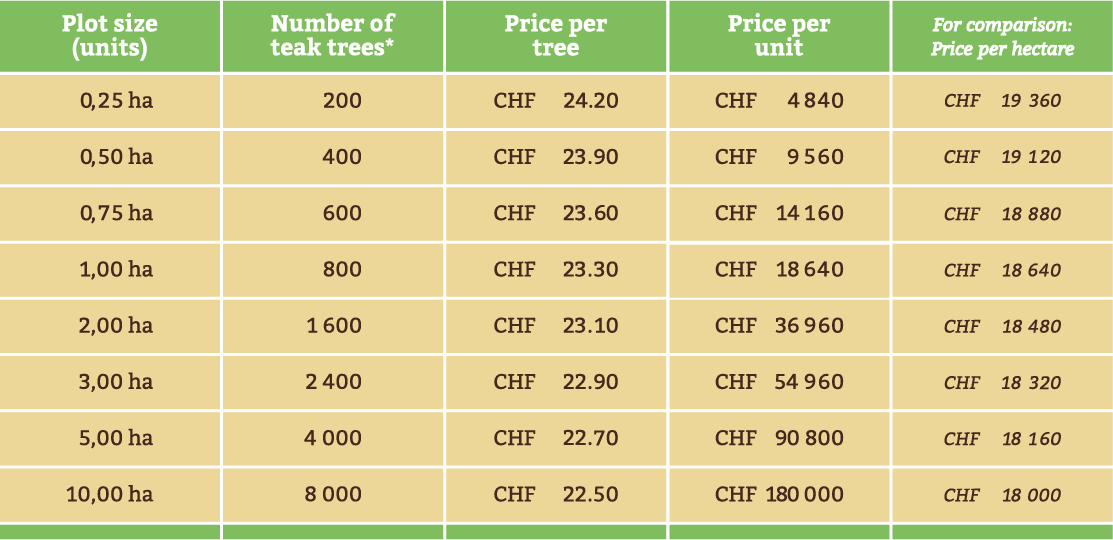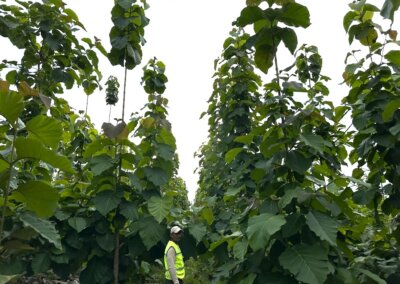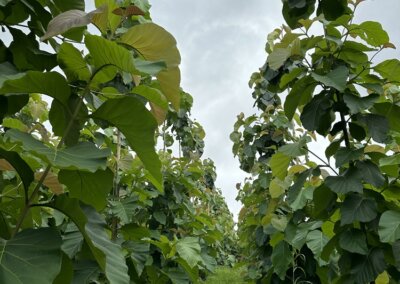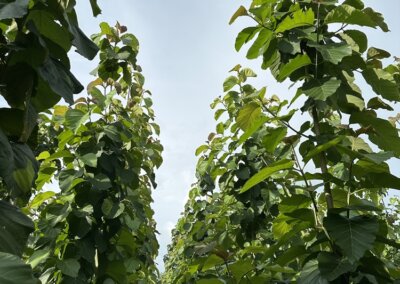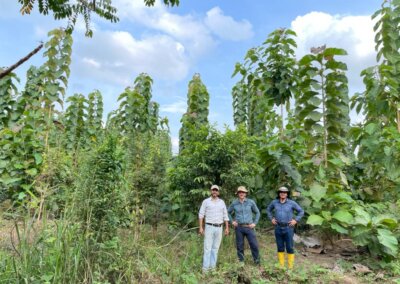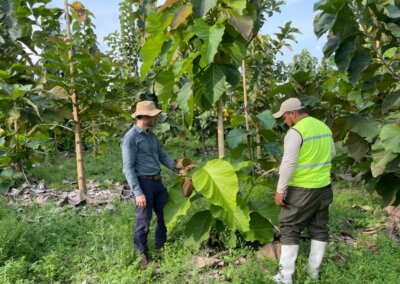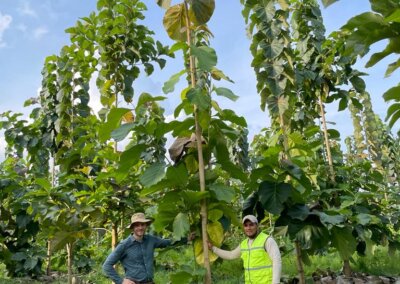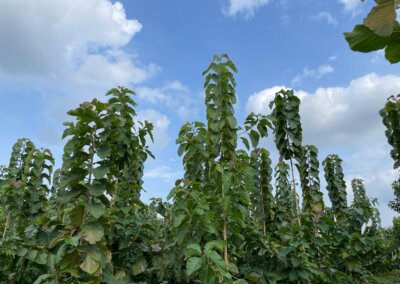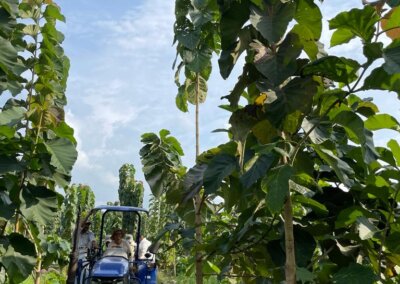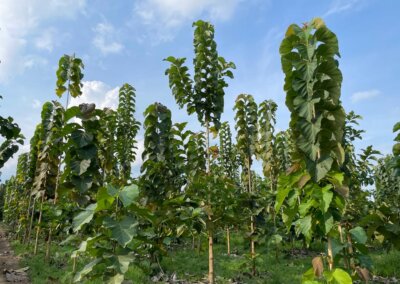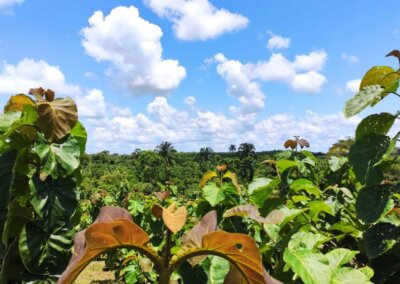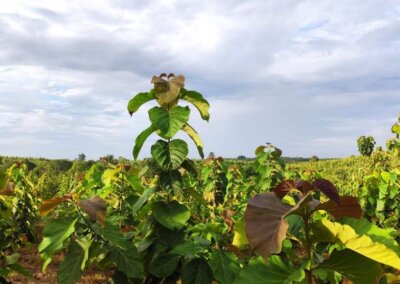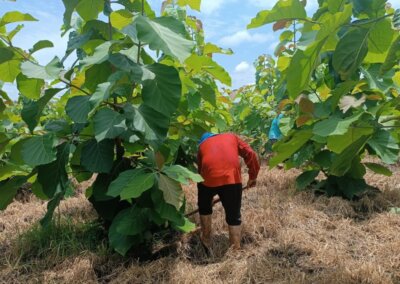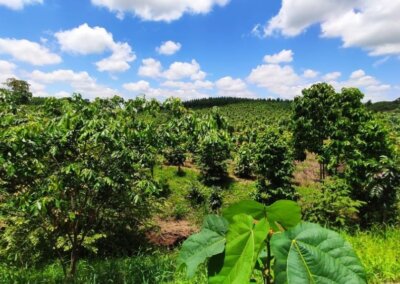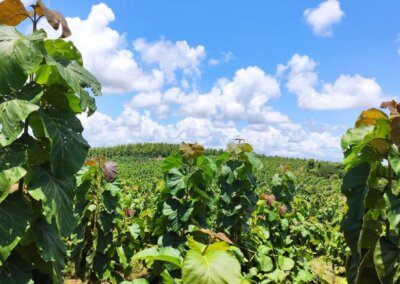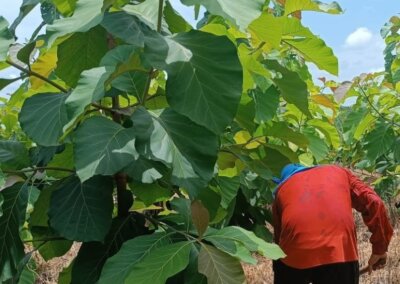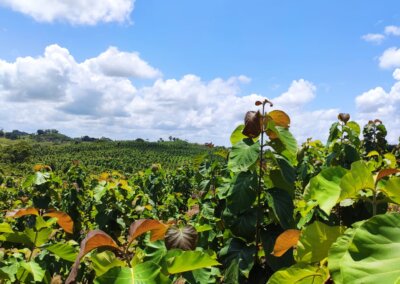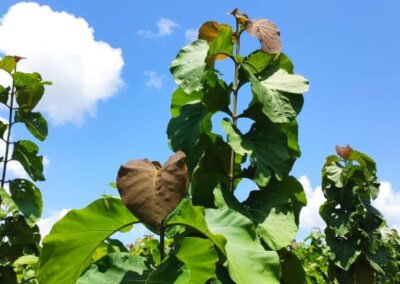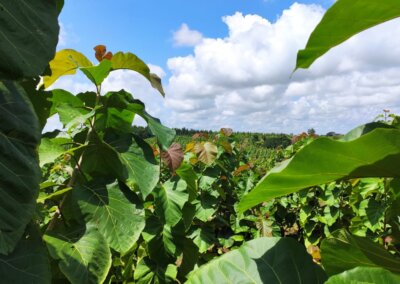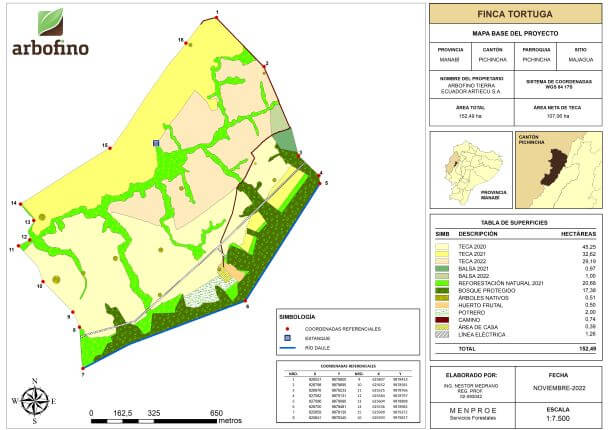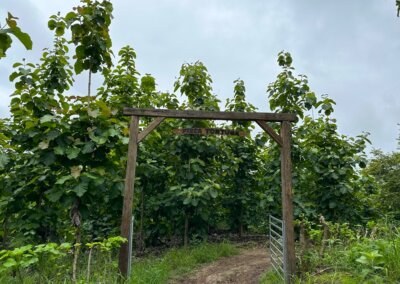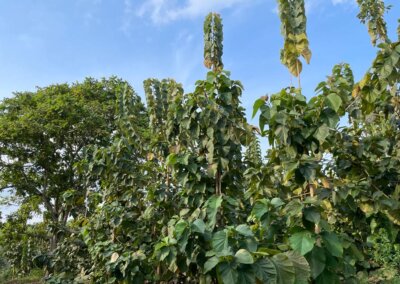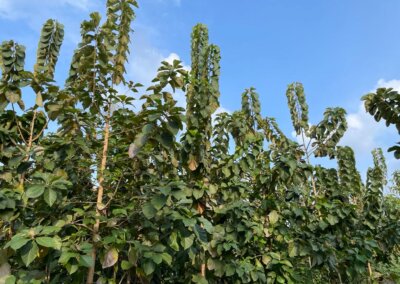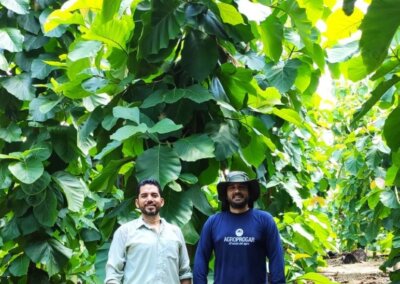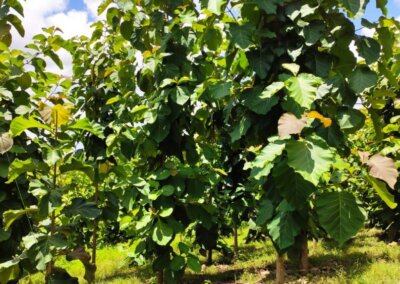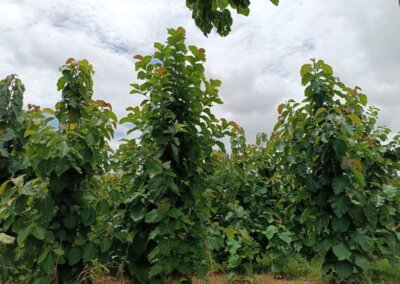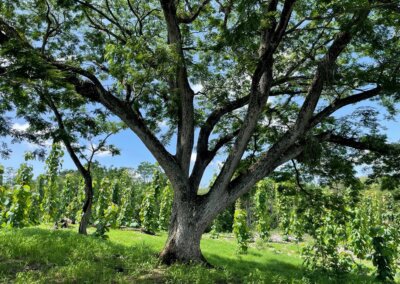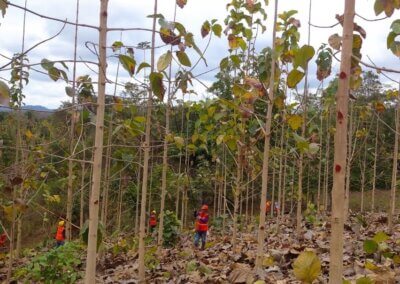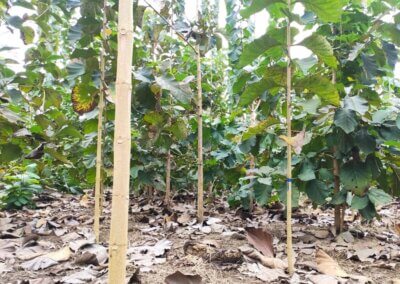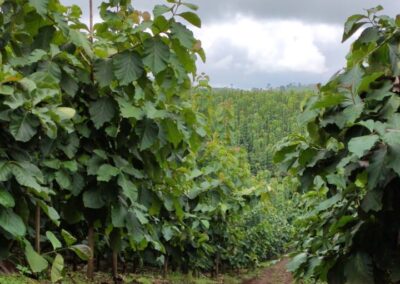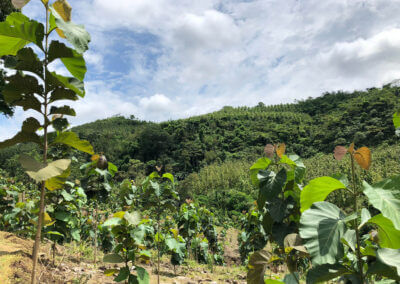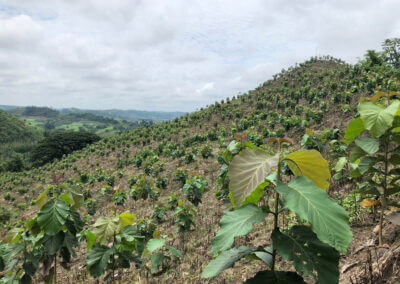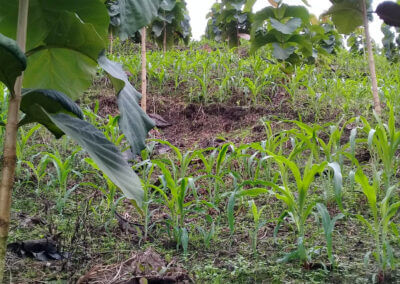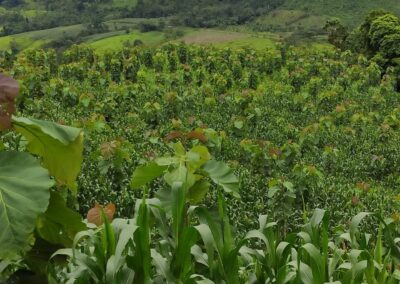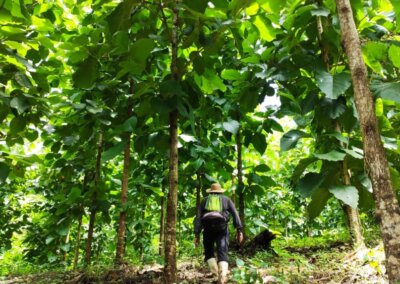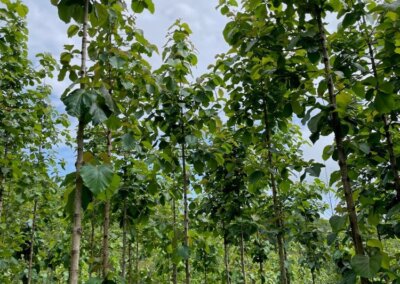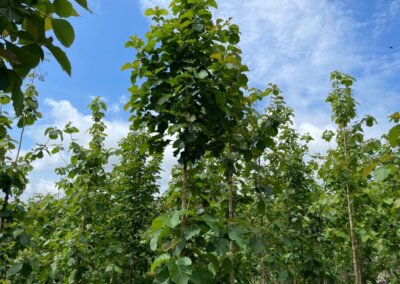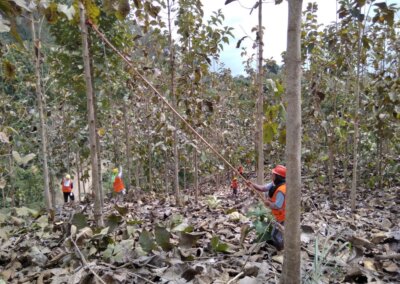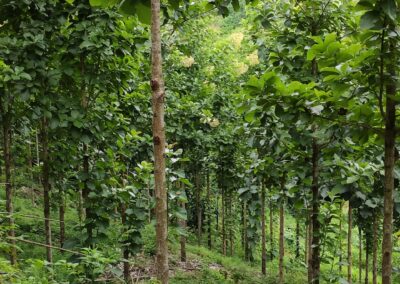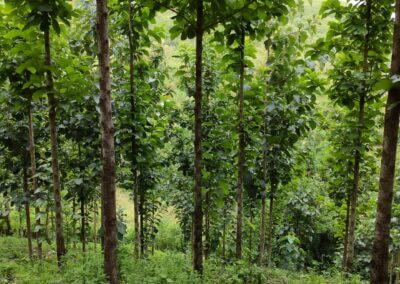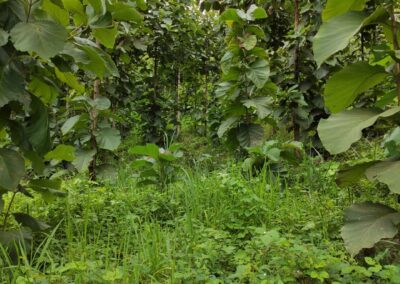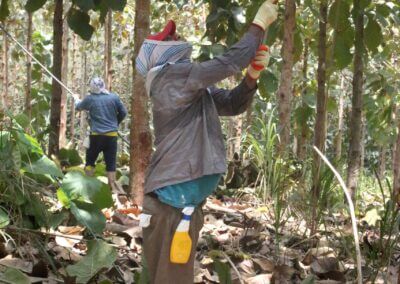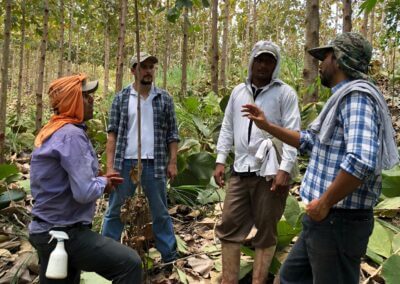Teak Impact Investment
We are convinced that each individual must take on more responsibility. Thus, an investment should not only generate a return, but also contribute to solving the major ecological and social problems of our planet. For us and our tree owners, it goes without saying that with every commercial plantation a measurable positive impact needs to be achieved at the same time.
For every hectare of teak, half a hectare of nature reserve is created
As an Impact Investor, you do not only pay for your teak trees, but at the same time you fund a protected area to promote biodiversity. In other words, for every hectare of teak about ¼ hectare of natural forest is being reforested and the same area of secondary forest protected. This means that a 20-hectare teak plantation simultaneously includes the creation of a 10-hectare conservation area, which can be checked on site at any time.
Biodiversity monitoring is used to record changes in species diversity over the long term, the carbon storage capacity of the forest is analyzed by measuring tree growth, and awareness is raised among the local population through educational work. Through this commitment, we as a company, together with our investors, can make a small but valuable contribution to the sustainable development goals of the United Nations.
How it works

The shortest possible description of our impact investment concept:
You buy already planted seedlings.
We make sure that they are professionally nurtured and cared for at all times.
We sell the wood for you within 20 years (several harvests) and transfer the net proceeds from your trees to you.
With your investment you fund simultaneously the conservation of valuable secondary forest and active natural reforestation to promote biodiversity.
We are a service provider who looks after your trees and sells your wood on your behalf. Our concept is neither a financial participation nor a financial product. And very important to mention, the professional management of the plantations, sustainability, transparency and the personal touch are what we focus on.
To hedge a part of your assets in the form of trees is nothing new. Institutions such as renowned universities or wealthy noble families have been relying on nature for generations to preserve and increase their wealth. It goes without saying that this requires patience. Although the teak trees are growing at an astonishing rate, it takes at least twenty years to produce high quality wood. Patience on the other hand, pays off in the truest sense of the word with this type of investment.
As an investor you buy a precisely defined stock of trees, whose ownership is transferred to you. The land remains in the possession of Arbofino and is secured by a separate subsidiary company. When you buy the trees, you pay a fixed price per seedling. After that, there are no further costs for you as tree owner. After receiving the purchase amount, we make the necessary provisions for the professional management of your trees until the end of the term.
Caution: Trees in the portfolio are recommended for diversification from an investment strategy perspective. In this case, short-term liquidity is deliberately limited. Of course, you are free to resell your trees at any time. If the situation requires it, we will be happy to assist you in finding a suitable buyer, free of charge of course. However, the time it takes to find a buyer depends on the market.
Timber Harvests
Harvest cycles
We plant about 840 trees per hectare. At the final harvest, about 220 of these trees are still standing. With several thinnings during the plantation cycle enough space is being created for the best trees to grow ideally. The high number of seedlings during the creation of the plantation is therefore one of the basic requirements for qualitatively excellent trees at the final harvest.
The first major thinning is done after 3 to 5 years. Between years 8 and 15 there will probably be two commercial thinnings. We cannot and do not want to commit ourselves to a fixed date. In order to take into account the latest forestry knowledge as well as local conditions at all times, the plantations are permanently supervised by an experienced forestry expert. We pursue the goal for our tree owners to achieve the highest possible volume with the best possible quality wood at the final harvest. Intermediate harvests are therefore not used to maximize the timber yield at that time, but to leave the best trees for the final harvest after about 20 years.
Depending on the market situation, it is possible to delay this final harvest by a maximum of five years, as a further objective is to achieve the best possible timber price. Growing the trees is one thing, selling them at the right time in the right place is another.
Wood volume
After 20 years about 220 trees are harvested per hectare. This corresponds approximately to a commercial timber volume of 140 m3 per hectare. Only the trees with the best trunks are left until the final harvest. A high quality log should be as straight, cylindrical and knotless as possible and have a diameter as large as possible with a high proportion of heartwood. These factors depend not only on professional management but also on the location and the genetic conditions, i.e. the seed quality.
Thinning ensures that the remaining trees always have enough space for optimal growth. There will probably be two commercial thinnings between the years 8 to 15. This means that part of the logged trees from this intermediate harvest can already be sold at a profit. During the first harvest, only a small amount of commercially usable wood is produced, about 15 m3 per hectare. In the second commercial intermediate harvest, this volume of wood is about 45 m3 per hectare. As a rule, the best quality timber is exported, while lower quality timber is sold on the local market at corresponding prices if possible. However, the time of thinning as well as the number of trees to be logged with the resulting timber volume depends on the current situation on the plantation and cannot be predicted exactly.
Return
Of course, as a tree owner, the economic yield that can be achieved with teak trees is of particular interest. This depends on two further factors besides the quality of the wood: On the one hand from the volume of wood, particularly from the final harvest, and on the other hand from the timber price you get on the market. The good news is that thanks to decades of experience with teak plantations, it is possible to estimate the volume roughly. The prerequisite for this is, of course, that you use certified seed material for the seedlings, choose the right location and manage the plantation professionally. The speculative part is the price. Where this will be in 20 years no one can predict. A look at the price development of the last few years and the worldwide demand for timber, especially in view of the scarce supply of precious wood, allows us to look optimistically into the future, but we cannot promise anything either. In addition to the economic return, our projects also have a positive effect on the local people and nature. You can find more about this under trust.
Considering the current market situation, you can expect an annual return of 3 – 6 % on your invested money. With further increasing prices the return can be higher and vice versa. The achievable prices per cubic meter depend on the circumference of the log, the heartwood percentage and the quality of the wood (e.g. knot purity). Not every part of a trunk and not every tree is therefore equally valuable. There is no world market price for teak, but the International Tropical Timber Organization (ITTO – www.itto.int) publishes every two weeks the current prices paid on the Indian market, the most important market for plantation teak. The lower part of a trunk of 20-year-old teak currently reaches prices of about 450 – 700 USD per m3.
Arbofino further receives a commission of 7% of the net proceeds from the timber sale. As a matter of fact, it is in our own interest to achieve the best possible sales price, which gives you as a tree owner an additional security.
Model calculation for teak revenue per hectare
1 total from thinnings and final harvest
2 after harvesting costs, taxes in producer country & commission
3 IRR = Internal Rate of Return
Note: The model calculation for teak revenue is based on the Hoppus formula (commercially usable volume), a term of 20 years from the year of planting and a purchase price of CHF 18 000 per hectare for 800 trees. The exact years for the commercial thinnings and the number of trees logged in each thinning depend on the local conditions on the respective plantation. The revenue figures used in the example are merely non-binding guidelines and forecasts which vary according to the situation, market condition as well as exchange rate and cannot be guaranteed.
Opportunities & Risks
As transparency, honesty and openness are important to us, we make sure that our investors understand the concept from the very beginning. “No opportunities without risks” also applies to trees as tangible assets. It is hardly surprising that we rate the opportunities significantly higher than the risks. Nevertheless, it is important to note that there are no guarantees for timber yield or monetary return. The risks listed here are borne entirely by the investor being the owner of the tree, right up to a possible total loss. Since it is well known that one question leads to the next, we recommend a personal conversation.
Once you have made your decision, you should enjoy your trees and look forward to participating in their further life story. The following table is intended to be a helpful orientation and possible preparation for a conversation.
CHANCEN
Demand / Market
Teak from natural forests is becoming less and less available, which is why, according to the FAO (Food and Agriculture Organization of the United Nations), the outlook for price and demand for plantation teak is promising.
The demand for teak plantation timber is enormous, especially in India. But China and other Asian countries also have a great need for precious woods due to their population growth and the increasing prosperity of certain population segments. After processing the wood it is often exported from Asia to Western Countries
Location Ecuador
Ecuador offers ideal climatic conditions for growing teak. In addition, due to decades of experience in teak cultivation, there is a lot of expertise available in the country. After Brazil, Ecuador is the largest teak exporter in Latin America.
Growth
Growth in the tropics is much higher than in our latitudes due to climatic conditions. In addition, the teak tree belongs to the fast-growing species despite its high wood quality. Due to the annual increase in volume it is called a natural compound interest.
Resistance in cultivation
Teak trees are extremely robust and easy to maintain. Thanks to decades of experience in cultivation, many risks can be excluded or minimized in advance.
Raw material precious wood
Precious wood is a high quality natural product whose occurrence is limited. It is not possible to react to an increased demand at short notice. Precious wood, which accounts for only four to five percent of the global timber market, is much less affected by price fluctuations than conventional timber.
Wood properties
Teak owes its popularity to its unique physical and visual properties. This makes it hardly replaceable and offers a wide range of uses.
Independence
A tangible asset investment in trees is independent of the capital markets and, as part of the real assets, a hedge against inflation. In addition, the trees continue to grow and thus increase their value from year to year.
CO2 Absorption
Teak trees absorb an above-average amount of CO2 and thus contribute to the fight against global warming.
Nature
In addition to the teak plantations, Arbofino also carries out strategic reforestation of natural forest and protects existing valuable secondary forest to promote biodiversity.
Social affairs
Arbofino guarantees fair working conditions as well as employment contracts with accident and social insurance for all plantation employees. Whenever available, temporary plantation employees are sought from the local population. In addition, a close contact and personal exchange is maintained with them.
RISKS
Unsuitable location
Ideal climatic conditions and the right soil are essential for suitable growth conditions. Our soil samples (for the first time already before the purchase of the land) are analyzed in the laboratory to have certainty that the trees have ideal conditions.
Insufficient plant seed quality
The yield per hectare depends heavily on good seed material. We obtain this from established, trustworthy suppliers, from whom we require a certification of origin of the seeds.
Inadequate cultivation
Insufficient care of the plantation leads to reduced growth due to competing plants and poor wood quality due to crooked and knotty trunks. Our reliable plantation manager is supported by advice and guidance from the forest engineer. Both report to us regularly.
Insect infestation & diseases
The teak tree is characterized by natural chemical compositions that make it extremely resistant to insects and diseases. Nevertheless, fungal diseases or insect infestation cannot be ruled out even in teak trees. The most sensitive phase is in the first 3 – 4 years, as little or no heartwood has been formed. It is important to have professional monitoring in order to take the necessary measures as quickly as possible in the event of an infestation, so that damage and further spread can be avoided as far as possible.
Lightning
As everywhere, there is the possibility that lightning strikes a tree or a group of trees. However, these events are rare and very selective.
Wind
Young trees with little or no heartwood are very flexible. After strong winds, it may happen that some of the young trees do not straighten up completely and have to be fixed in the vertical position with cords for a short period of time. In case of extraordinary wind events some of the young trees may also break. With the high initial planting density, such incidents are already considered in advance. Nevertheless, even a young tree that had been broken by winds and then was felled can reappear and benefit from the existing root system. With the first thinning, inferior trees are then removed early to create the necessary space for the ideal growth of the remaining trees. Healthy older trees can usually withstand strong winds. Arbofino does not maintain plantations in areas endangered by tropical storms such as hurricanes.
Fire
The teak tree is characterized by an extremely high fire resistance from the age of five years. Correct maintenance as well as permanent monitoring of the plantation are further important factors in preventing fire events. Additionally, the plantations are protected by firebreaks.
Flooding
The teak tree does not like waterlogging, which is why flood-prone areas are not suitable without construction measures. This risk can be eliminated by choosing an ideal location.
Theft
Older trees have a high value and can be a lucrative target for wood theft. With well-monitored plantations, however, theft can be avoided. In addition, the plantation is difficult to access except from the access road.
Political risks
Political uncertainties are higher in developing countries like Ecuador than at our place. Ecuador is a presidential democracy. The last president, Rafael Correa, was in office for ten years and was replaced by Lenín Moreno in 2017. Like many Latin American countries, Ecuador has made great progress in recent years. The economy is dependent on international trade, export and foreign investment, which is why the government does a lot for their legal security and secures it through various intergovernmental agreements. The forestry and agricultural sector are also supported by various government incentive programs.
Market
As with all products, there is no demand or price guarantee. Long-term forecasts are difficult despite the points mentioned under “Opportunities”. The advantage of wood is that the moment of harvest is flexible and can be adapted to the current market situation.
Teak
Teak is one of the best known tropical precious wood. It comes originally from India, Myanmar, Laos and Thailand. In Indonesia, the teak tree was already cultivated in plantations by Dutchmen in the middle of the 17th century. But also in Central and South America one looks back on decades of experience in teak cultivation.
Unfortunately, most natural teak stocks have already fallen victim to the rapid deforestation of the rainforests. The largest natural teak stocks left are in Myanmar, but what ends up on the world market often comes from illegal exploitation or unsustainable forestry. Even if a plantation tree cannot keep up with a rainforest giant, an important part of the demand can be covered.
Thanks to its excellent properties, teak has been used worldwide for indoor and outdoor flooring, garden furniture, boat and shipbuilding, among other things, and in the Asian region for centuries also for construction. It owes its fame to its optical as well as physical properties, as it is hardly substitutable and very versatile.
Invest
The price of a plot depends on the number of trees. The theoretical value is approximately 830 trees per hectare. Due to the natural site condition in the field the number of trees (*) on a plot may slightly differ from the theoretical value.
Therefore, only 800 trees per hectare are being charged. However, in the contract always the actual number of planted trees is stipulated. The minimum investment is a quarter of a hectare, which corresponds to 200 trees for CHF 4’750. Since the pattern of the plots in the plantation is adapted to the local conditions, the size of the plots usually varies slightly.
Price list new plantation
We currently have teak trees on offer at our Finca Tortuga with the planting year 2021 (price list teak 2021) as well as planting year 2022 price list teak 2022 – available from 1 ha. We would be happy to make you an offer based on the plots still available. Current pictures and the map of the plantation can be found below under “Plantations”.
Plantations on sale
Teak planting year 2022, 29 hectares, Finca Tortuga (available for plot sizes from 1 hectare)
Teak planting year 2021, 32 hectares, Finca Tortuga
Teak planting year 2020, 45 hectares, Finca Tortuga




